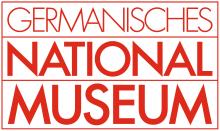 | |
 Main entrance | |
 | |
| Established | 1852 |
|---|---|
| Location | Nuremberg, Germany |
| Coordinates | 49°26′53.99″N 11°4′32.02″E / 49.4483306°N 11.0755611°E |
| Visitors | 405,799 (2010) |
| Director | Daniel Hess |
| Public transit access | U2/U3: Opernhaus; U1: Lorenzkirche |
| Website | www |
The Germanisches Nationalmuseum is a museum in Nuremberg, Germany. Founded in 1852, it houses a large collection of items relating to German culture and art extending from prehistoric times through to the present day. The museum is Germany's largest museum of cultural history. Out of its total holding of some 1.3 million objects (including the holdings of the library and the Department of Prints and Drawings), approximately 25,000 are exhibited.[1]
The museum is situated in the south of the historic city center between Kornmarkt and Frauentormauer along the medieval city wall. Its entrance hall is situated on Kartäusergasse which was transformed by the Israeli sculptor Dani Karavan to the Way of Human Rights (German: Straße der Menschenrechte).
- ^ "GNM FAQ (English)". Archived from the original on 21 December 2021. Retrieved 24 July 2019.